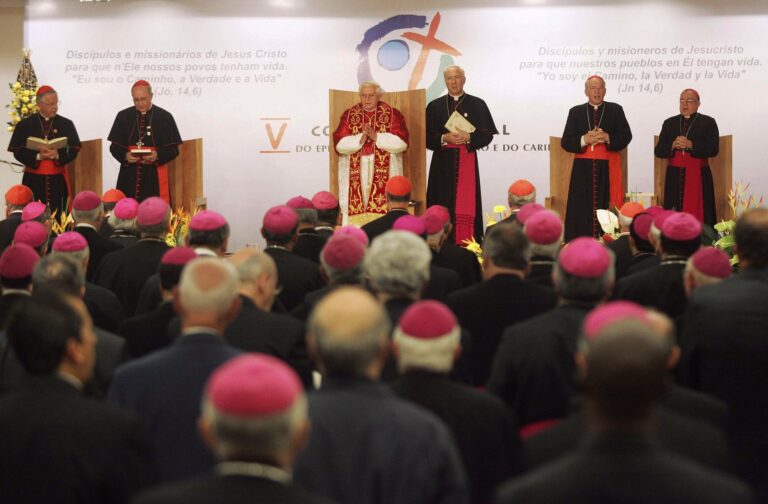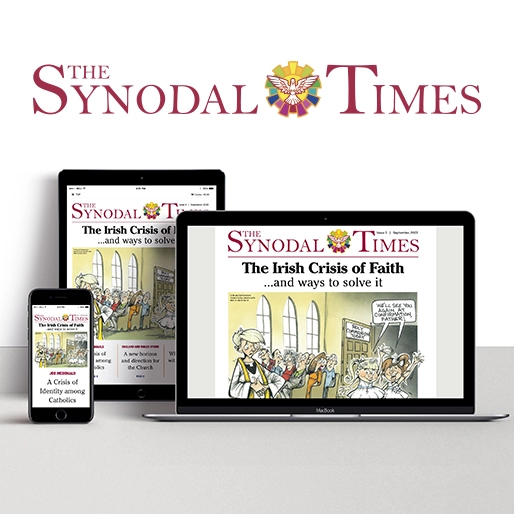As we build a new ecclesial model for the third millennium, Pope Paul VI’s words still hold true for explaining the transition the Church must go through. In 1969, he warned: “In the formation of the new ecclesial mentality…there are those who expect that, as the Church progresses in awareness of herself, there will be a dissolution of the juridical relations and bonds that constitute her as the mystical, visible and organic body of Christ in the historical reality of the world; and there are those who consider this doctrinal process to be a transfer of powers whereby the Church fulfills its mission, to the benefit of the lower degrees compared to the higher ones in the people of God.
For our part, we view the Church rather as a deep and organic solidarity”. Today, this organic body of the Church bears the wounds of a fractured institutional model suffering from clericalism. As the Latin American ecclesiologist Ronaldo Muñoz said in 1972, “The clerical institution is one of the great structural obstacles to discovering the Gospel”.
In this sense, the transition toward a new model for the third millennium needs to recognise, first, that we are facing a systemic and structural problem that reveals the weakness of the dominant theological-cultural model, which has become outdated and needs not only renewal but also reform.
Amid the polarisation resulting from inadequate reception of the Second Vatican Council, we need to remember that “the Church, as the people of God, reveals and gives substance to her being as communion when all her members journey together, gather in assembly, and take an active part in her evangelising mission”.
Reception
Thus, to advance in the reception of the Second Vatican Council, there must be a synodal reconfiguring of the ecclesiastical institution, and it must start from the hermeneutical primacy of chapter 2 of Lumen Gentium (“On the people of God”), which recognises the binding and permanent character of the sensus fidei fidelium in creating the consensus omnium fidelium.
Synodality is more than a synod or a council. Apart from questions about participating in synods or renewing the exercise of collegiality, the challenge is to synodalise the whole Church and create new structures for this process. Consequently, there is an urgent need to reform the identity and vocation of the ordained ministry so that laypeople are recognised as subjects in virtue of the “radical equality of all through baptism”.
Such an opening would allow for new relational and communicative dynamics that would help to overcome clericalism. They would also facilitate the processes of listening, discerning, and joint decision-making that express the sensus ecclesiae totius populi. Such an advance toward synodal ecclesiality requires both a reconfiguration of the identity and interaction of ecclesial subjects within the people of God and a further deepening of episcopal collegiality. Thus, it is necessary to “reform relations and institutions”.
In this process, the experience of the base ecclesial communities are very instructive because they have shown that communal discernment “from below” is an effective way to link the processes of decision-making and decision-taking. For, although synodality takes shape in our walking and meeting and sharing together, it reaches completion only when we discern and make decisions together.
As we have seen, synodality “needs to be institutionally translated into places, instances, and organs in which it can be practiced”, and it should express “the circular relationship between the ministry of pastors, the participation and co-responsibility of lay people, and the stimulus coming from the charismatic gifts according to the dynamic circular link between ‘one,’ ‘some,’ and ‘all’” (ITC, Syn 106).
Another illustrative experience can be found in the episcopal ministry of Saint Cyprian, bishop of Carthage, who in the third century proposed that there be “collaborative consultation of bishops, priests, deacons, confessors, and also a substantial number of laity…because no decree can be established that is not ratified by consent of a plurality”.
If all the faithful take part in the elaboration of decisions, then the decisions made will be an expression of the counsels that the community has given, by exercising its essential pastoral co-responsibility. Moreover, the decisions will be accepted and ratified by the bishop not as his own opinion but as the sensus totius ecclesiae, of which he is the authorised representative.
Authority
As Severino Dianich maintains, “no form of valid, authentic authority is conceivable outside of the ecclesial consensus”. We have also seen the value of the model proposed by the Latin American bishops in their successive meetings, from 1968 in Medellín to Aparecida in 2007.
They sought convergences and proposed an ecclesial reconfiguration based on an ecclesiology of small communities. In this sense, the practice and implementation of synodal ecclesiality will have the task of imagining a Church for the third millennium that is, in the words of the Italian theologian Serena Noceti, “open to facilitating complex processes of community discernment involving parishes, priests, the faithful, and theologians”.
The Church needs, therefore, a new ecclesial way of proceeding in which, according to the Belgian canonist Borras, “the consultative organs elaborate the decision, the final responsibility for which falls to the pastoral authority that assumes it”, thus excluding authorities that have not participated in the processes.
With this objective, the document Synodality in the Life and Mission of the Church, published by the International Theological Commission, has clearly stated that “the synodal dimension of the Church must be brought out by enacting and directing discernment processes which bear witness to the dynamism of communion that inspires all ecclesial decisions” (ITC Syn 76), because “what affects all must be discussed and approved by all”.
Thus, making a commitment to “greater synodality requires correct application of canonical dispositions, proper understanding of decision-making modalities, and profound confidence in the people of God—all of which must be linked to the elaboration of the decisions that the pastors must make in order to realise ‘the missionary aspiration of reaching everyone’” (EG 31).
As we have seen, all this presupposes, among other things, a richer theology of the source and exercise of potestas in the Church and its relationship with governance. This is perhaps one of our greatest challenges, but it is important for overcoming clericalism and enabling a new ecclesial culture characterised by dialogue, mutual listening, consulting, consensus building, and accountability at all levels.
We must not lose this privileged moment for carrying out a synodal reconfiguration of the Church involving “spiritual, pastoral, and institutional reforms” (Aparecida 367). Such synodal reconfiguration of the Church is necessary for the conversion of an institution that has been exceedingly self-referential; the Church, by moving away from its own centre, will represent more fully the people who mediate the voice of Christ. Once more, the normativity of the ecclesiology of the people of God is essential.
Following Lumen Gentium 12, the document Episcopalis Communio reminds us that it is the totality of the faithful that can “show universal agreement in matters of faith and morals”; that totality includes all who make up the people of God, “from bishops to the last of the lay faithful” (EC 5).
Hierarchy
The task of the hierarchy, therefore, is to create the “concrete mediations” that are necessary for involving all the faithful. A good example is the request made by the Latin American bishops that even “the laity participate in the discernment, the decision taking, the planning, and the execution” of ecclesial matters (Aparecida 371).
This point was also made by Pope Francis regarding the participation of women in the Church, when he stated, “Since lay men and women are protagonists in the Church…we must promote the integration of women in places where important decisions are taken”, and not only where decisions are made or elaborated. Congar helps us to understand how difficult it is to advance further in considering the laity as full subjects and not mere objects in the Church.
He wrote: “We are still far from understanding the consequences of discovering…that the entire Church is a single people of God and that it is made up of the faithful along with the clergy. We still implicitly have the idea that the Church is formed by the clergy and that the faithful are only their beneficiaries or clientele. This frightful conception has been inscribed in so many structures and customs that it seems almost natural and immutable. This is a betrayal of the truth. Much still remains to be done to declericalise our conception of the Church”.
Today, we can say that this understanding will come about only by means of personal conversions and structural reforms inspired by the new ecclesial hermeneutics of respectivity and reciprocity among all ecclesial subjects.
Synodality expresses a new way of proceeding that “has its point of departure but also its point of arrival in the people of God” (Episcopalis Communio 7). In other words, “synodality is a constitutive dimension of the Church, and through synodality the Church reveals and configures herself as the pilgrim people of God”.
Exposition
In view of this exposition, we can safely affirm that reforming a failed institutional model requires generating a new process of ecclesiogenesis, a process that requires in turn authentic theological pastoral conversion, re-creation, and re-education or re-learning. It is necessary to touch the very heart of ecclesiology and not just reorganise structures superficially”.
As we have noted, a renewed Church, as opposed to a new Church, involves not only creative reception of the Council but also theological-cultural re-creation of the foundational spirit that led to the Church’s original formation.
It is necessary to renew the identities and good practices of institutions and the mentalities of ecclesial subjects in order to create the new structures and interactions needed for a synodal Church whose “internal institutions must become more fraternal, more participatory, more open to dialogue, more flexible, and more poor”.
Such an ecclesiogenesis leads us to think beyond what now exists so that we allow the Spirit to move us into a new creative phase of receiving and implementing the Second Vatican Council. For, as Congar reminds us: “We must ask ourselves whether aggiornamento is enough or whether something else will not be necessary.
The question becomes urgent to the extent that the Church’s institutions are rooted in a cultural world that no longer has a place in the new cultural world. Our epoch requires a revision of “traditional” forms that goes beyond the plans for adaptation or aggiornamento; it requires a new creation. It is not enough simply to maintain and adapt what has existed until now; it is necessary to create something new.
Mission
Christianity is essential transmission, traditio. The only things that can be re-invented are the forms of what has been received. To make the transmission—the paradosis— effective and authentic, we must revise and renew the forms that served well for transmission in other times but that now prove to be obstacles to genuine transmission.
Let us finish as we began, that is, by evoking the words of Pope Paul VI in his opening speech at the second session of the Second Vatican Council on September 29, 1963. There, he gave voice to the “desire, the need, and the duty of the Church finally to provide a more complete definition of itself”.
In this new phase of the Council’s reception that began with the pontificate of Francis, we are faced with the challenge of building a synodal ecclesiality for the third millennium by advancing in the hermeneutics and the reception of the Church as people of God. Only in this way will we fulfill Pope Paul VI’s call for “a more complete definition of the Church”. That is what synodality represents today.
This extract is from Synodality – A New Way of Proceeding In The Church by Rafael Luciani and published by Paulist Press. Republished here with permission.



